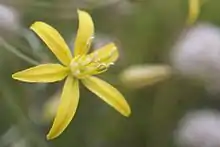Bloomeria crocea
Bloomeria crocea, also known as goldenstar, is a geophyte from southern California and northern Baja California. It is found along hillsides, in grassland and chaparral edges, and in dry flats.
| Bloomeria crocea | |
|---|---|
 | |
| Bloomeria crocea near Pomona, California | |
| Scientific classification | |
| Kingdom: | Plantae |
| Clade: | Tracheophytes |
| Clade: | Angiosperms |
| Clade: | Monocots |
| Order: | Asparagales |
| Family: | Asparagaceae |
| Subfamily: | Brodiaeoideae |
| Genus: | Bloomeria |
| Species: | B. crocea |
| Binomial name | |
| Bloomeria crocea | |
.jpg.webp)
Description
The Bloomeria crocea corm has a fibrous exterior and usually produces only one leaf. Plants produce six-petaled golden flowers that are clustered in a loose umbel. When the three-lobed stigma is fertilized, Bloomeria produces capsules that contain small black seeds. The seeds then require three to four years to become a mature plant.
Distribution
Growing in full sun, Bloomeria crocea prefers porous soil and semi-dry conditions, in the Peninsular, Transverse, and southern California Coast Ranges, and on the Channel Islands. Its distribution is found along the southern coast from Santa Barbara County and western Kern County, through Southern California, down into Baja California.
References
- "Bloomeria crocea (Torr.) Coville". The Plant List. Retrieved 15 February 2015.
- Growing California Native Plants. 1980. Marjorie G. Schmidt.
- "The Jepson Manual," Jepson Flora Project, Jepson Interchange. Copyright © 1993 by the Regents of the University of California [web application]. Treatment at: http://ucjeps.berkeley.edu/cgi-bin/get_JM_treatment.pl?8349,8435,8436
- USDA, NRCS. 2006. The PLANTS Database, Version 3.5 (http://plants.usda.gov)%5B%5D. Data compiled from various sources by Mark W. Skinner. National Plant Data Center, Baton Rouge, LA 70874-4490 USA.
External links
| Wikimedia Commons has media related to Bloomeria crocea. |